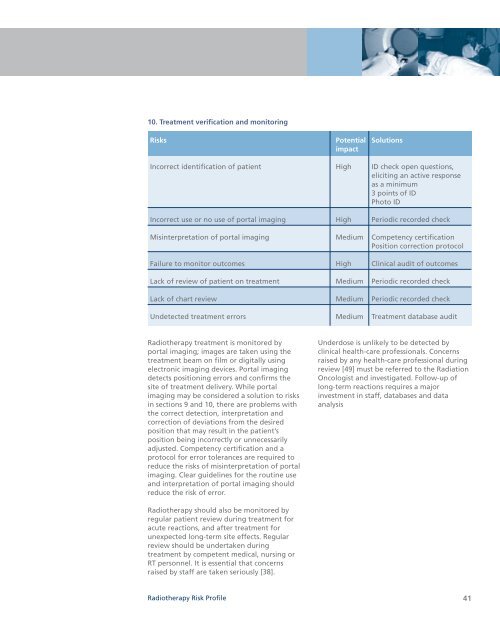RADIOTHERAPY RISK PROFILE - World Health Organization
RADIOTHERAPY RISK PROFILE - World Health Organization
RADIOTHERAPY RISK PROFILE - World Health Organization
Create successful ePaper yourself
Turn your PDF publications into a flip-book with our unique Google optimized e-Paper software.
10. Treatment verification and monitoring<br />
Risks Potential Solutions<br />
impact<br />
Incorrect identification of patient High ID check open questions,<br />
eliciting an active response<br />
as a minimum<br />
3 points of ID<br />
Photo ID<br />
Incorrect use or no use of portal imaging High Periodic recorded check<br />
Misinterpretation of portal imaging Medium Competency certification<br />
Position correction protocol<br />
Failure to monitor outcomes High Clinical audit of outcomes<br />
Lack of review of patient on treatment Medium Periodic recorded check<br />
Lack of chart review Medium Periodic recorded check<br />
Undetected treatment errors Medium Treatment database audit<br />
Radiotherapy treatment is monitored by<br />
portal imaging; images are taken using the<br />
treatment beam on film or digitally using<br />
electronic imaging devices. Portal imaging<br />
detects positioning errors and confirms the<br />
site of treatment delivery. While portal<br />
imaging may be considered a solution to risks<br />
in sections 9 and 10, there are problems with<br />
the correct detection, interpretation and<br />
correction of deviations from the desired<br />
position that may result in the patient’s<br />
position being incorrectly or unnecessarily<br />
adjusted. Competency certification and a<br />
protocol for error tolerances are required to<br />
reduce the risks of misinterpretation of portal<br />
imaging. Clear guidelines for the routine use<br />
and interpretation of portal imaging should<br />
reduce the risk of error.<br />
Radiotherapy should also be monitored by<br />
regular patient review during treatment for<br />
acute reactions, and after treatment for<br />
unexpected long-term site effects. Regular<br />
review should be undertaken during<br />
treatment by competent medical, nursing or<br />
RT personnel. It is essential that concerns<br />
raised by staff are taken seriously [38].<br />
Radiotherapy Risk Profile<br />
Underdose is unlikely to be detected by<br />
clinical health-care professionals. Concerns<br />
raised by any health-care professional during<br />
review [49] must be referred to the Radiation<br />
Oncologist and investigated. Follow-up of<br />
long-term reactions requires a major<br />
investment in staff, databases and data<br />
analysis<br />
41

















